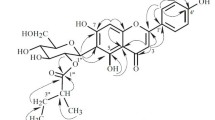Abstract
A major secondary metabolite of lichens, diffractaic acid, was found here to exert a significant antiviral action on respiratory syncytial virus strain A2 with a EC50 of 4.8 µM while showing low toxicity to a tested cell line (CC50 of 221.9 µM). We developed methods for the synthesis of derivatives at the hydroxyl group of diffractaic acid and obtained three series of new derivatives: those of diffractaic acid and of its methyl and benzyl esters. We noted that the most promising compounds are derivatives of benzyldiffractate, which typically were found to have same or lower cytotoxicity as compared to either methyldiffractate ethers or compounds with a carboxyl group. A combination of these modifications allowed to find a promising compound: a benzyldiffractate carrying a morpholin-4-yl-ethyl substituent (EC50 2.1 µM, CC50 368.5 µM, SI 175).






Similar content being viewed by others
References
Goga M, Elecko J, Marcincinova M, Rucova D, Backorova M, Backor M Lichen Metabolites: An Overview of Some Secondary Metabolites and Their Biological Potential. In: Merillon, JM, Ramawat, K (eds) Co-Evolution of Secondary Metabolites. Reference Series in Phytochemistry. Springer, Cham. 2018. https://doi.org/10.1007/978-3-319-76887-8_57-1
Zhao Y, Wang M, Xu B. A comprehensive review on secondary metabolites and health-promoting effects of edible lichen. J Funct Foods. 2021;80:104283 https://doi.org/10.1016/j.jff.2020.104283
Ureña-Vacas I, González-Burgos E, Divakar PK, Gómez-Serranillos MPJ. Lichen depsides and tridepsides: progress in pharmacological approaches. J Fungi 2023;9:116 https://doi.org/10.3390/jof9010116
Karagoz ID, Ozaslan M, Kilic IH, Guler I, Uyar C, Tuter D, et al. Hepatoprotective effect of diffractaic acid on carbon tetrachloride-induced liver damage in rats. Biotechnol Biotechnol Equip. 2015;29:1011–6. https://doi.org/10.1080/13102818.2015.1056754
Honda NK, Pavan FR, Coelho RG, Andrade Leite SR, Micheletti AC, Lopes TIB, et al. Antimycobacterial activity of lichen substances. Phytomedicine. 2010;17:328–32. https://doi.org/10.1016/j.phymed.2009.07.018
Bayir Y, Odabasoglu F, Cakir A, Aslan A, Suleyman H, Halici M, et al. The inhibition of gastric mucosal lesion, oxidative stress and neutrophil-infiltration in rats by the lichen constituent diffractaic acid. Phytomedicine. 2006;13:584–90. https://doi.org/10.1016/j.phymed.2005.07.002
Sachin MB, Mahalakshmi SN, Kekuda TRP. Insecticidal efficacy of lichens and their metabolites - A mini review. J Appl Pharm Sci. 2018;8:159–64. https://doi.org/10.7324/JAPS.2018.81020
Yamamoto Y, Miura Y, Kinoshita Y, Higuchi M, Yamada Y, Murakami A, et al. Screening of tissue cultures and thalli of lichens and some of their active constituents for inhibition of tumor-promoter-induced Epstein-Barr virus activation. Chem Pharm Bull. 1995;43:1388–90. https://doi.org/10.1248/cpb.43.1388
Loeanurit N, Tuong TL, Nguyen V-K, Vibulakhaophan V, Hengphasatporn K, Shigeta Y, et al. Lichen-derived diffractaic acid inhibited dengue virus replication in a cell-based system. Molecules. 2023;28:974 https://doi.org/10.3390/molecules28030974
Lozano R, Naghavi M, Foreman K, Lim S, Shibuya K, Aboyans V, et al. Global and regional mortality from 235 causes of death for 20 age groups in 1990 and 2010: a systematic analysis for the Global Burden of Disease Study 2010. Lancet. 2012;380:2095–128. https://doi.org/10.1016/S0140-6736(12)61728-0
Shi T, McAllister DA, O’Brien KL, Simoes EAF, Madhi SA, Gessner BD, et al. Global, regional, and national disease burden estimates of acute lower respiratory infections due to respiratory syncytial virus in young children in 2015: a systematic review and modelling study. Lancet. 2017;390:946–58. https://doi.org/10.1016/S0140-6736(17)30938-8
Falsey AR, Hennessey PA, Formica MA, Cox C, Walsh EE. Respiratory syncytial virus infection in elderly and high-risk adults. N Engl J Med. 2005;352:1749–59. https://doi.org/10.1056/NEJMoa043951
Rezaee F, Linfield DT, Harford TJ, Piedimonte G. Ongoing developments in RSV prophylaxis: a clinician’s analysis. Curr Opin Virol. 2017;24:70–78. https://doi.org/10.1016/j.coviro.2017.03.015
Heylen E, Neyts J, Jochmans D. Drug candidates and model systems in respiratory syncytial virus antiviral drug discovery. Biochem Pharm. 2017;127:1–12. https://doi.org/10.1016/j.bcp.2016.09.014
Elawar F, Oraby AK, Kieser Q, Jensen LD, Culp T, West FG, et al. Pharmacological targets and emerging treatments for respiratory syncytial virus bronchiolitis. Pharm Ther. 2021;220:107712 https://doi.org/10.1016/j.pharmthera.2020.107712
Lai D, Odimegwu DC, Esimone C, Grunwald T, Proksch P. Phenolic Compounds with In Vitro Activity against Respiratory Syncytial Virus from the Nigerian Lichen Ramalina farinacea. Planta Med. 2013;79:1440–6. https://doi.org/10.1055/s-0033-1350711
Baram GI, Grachev MA, Komarova NI, Perelroyzen MP, Bolvanov YA, Kuzmin SV, et al. Micro-column liquid chromatography with multi-wave-length photometric detection: I. The OB-4 micro-column liquid chromatograph. J Chromatogr A 1983;264:69–90. https://doi.org/10.1016/S0021-9673(01)95007-1
Köhler G, Milstein C. Derivation of specific antibody-producing tissue culture and tumor lines by cell fusion. Eur J Immunol. 1976;6:511–9. https://doi.org/10.1002/eji.1830060713
Acknowledgements
We would like to acknowledge the Chemical Research Multi-Access Center of SB RAS for the spectral and analytical measurements. The English language was corrected and certified by shevchuk-editing.com.
Author contributions
Chemistry: ASF, DUI, AAD, OAL; Analytical study: NIK; Biology: AAS, AVG, YVN, AMK, VZK; Writing - original draft preparation, review and editing: ASF, AAD, OAL, AAS; Supervision: NFS. All authors read and approved the final manuscript.
Funding
This research was funded by the Russian Science Foundation (grant No. 21-13-00026). The authors declare they have no financial interests.
Author information
Authors and Affiliations
Corresponding author
Ethics declarations
Conflict of interest
The authors declare no competing interests.
Additional information
Publisher’s note Springer Nature remains neutral with regard to jurisdictional claims in published maps and institutional affiliations.
Supplementary Information
Rights and permissions
Springer Nature or its licensor (e.g. a society or other partner) holds exclusive rights to this article under a publishing agreement with the author(s) or other rightsholder(s); author self-archiving of the accepted manuscript version of this article is solely governed by the terms of such publishing agreement and applicable law.
About this article
Cite this article
Filimonov, A.S., Ismangulova, D.U., Diveikina, A.A. et al. Diffractaic acid and its ethers as anti-respiratory syncytial virus agents. Med Chem Res 33, 677–686 (2024). https://doi.org/10.1007/s00044-024-03204-4
Received:
Accepted:
Published:
Issue Date:
DOI: https://doi.org/10.1007/s00044-024-03204-4




